The Huerta Agricultural Landscape in the Spanish Mediterranean Arc: One Landscape, Two Perspectives, Three Specific Huertas
Abstract
1. Introduction
2. Methodology. Comparative Case Studies
2.1. The Huerta Landscape of Valencia, Murcia, and Vega Baja Territorial Context in Brief
2.1.1. Huerta of Valencia
2.1.2. Huerta of Murcia
2.1.3. Huerta de la Vega Baja
3. Results. Huerta Landscape: Tangible Elements and Intangible Components
Functional Networks in Huerta Landscape
- Water distribution
- Pathway networks
- Settlement Patterns
- Agricultural Productive System
- Immaterial heritage: Management of water, the strongest community link
“The Huerta landscape encompasses, beyond the aforementioned physical features, several immaterial heritage hallmarks: the use of the term Huerta; water distribution regulations; responsibility for the upkeep of canals and paths; and a specific oral tribunal for the settlement of disputes. The Huerta’s immaterial features have different ancient origins, such as the Babylonian Code of Hamurabi, the Islamic law —Malikite law— and the Christian Al-Andalus tradition”.[47]
4. Discussion
5. Conclusions
Author Contributions
Funding
Conflicts of Interest
References
- Meeus, J.; Wijermans, M.; Vroom, M. Agricultural landscapes in Europe and their transformation. Landsc. Urban Plan. 1990, 18, 289–352. [Google Scholar] [CrossRef]
- European Environment Agency. Europe’s Environment—The Dobris Assessment; European Environment Agency: Copenhague, Denmark, 1995. [Google Scholar]
- Malek, Ž.; Verburg, P.H. Mediterranean land systems: Representing diversity and intensity of complex land systems in a dynamic region. Landsc. Urban Plan. 2017, 165, 102–116. [Google Scholar] [CrossRef]
- García-Marín, R.; Espejo-Marín, C.; Giménez-García, R.; Ruiz-Álvarez, V. Transformations in the Agricultural and Scenic Landscapes in the Northwest of the Region of Murcia (Spain): Moving towards Long Awaited (Un)Sustainability. Land 2020, 9, 314. [Google Scholar] [CrossRef]
- El Paisaje: Valores e Identidades; Martínez de Pisón, E., Ortega Cantero, N., Eds.; Ediciones de la Universidad Autónoma de Madrid, Fundación Duques de Soria: Madrid, Spain, 2009; ISBN 9788483441541. [Google Scholar]
- Olmo, R.M.; Muñoz, S.F. La Huerta de Murcia: Landscape guidelines for a peri-urban territory. Landsc. Res. 2004, 29, 385–397. [Google Scholar] [CrossRef]
- Vallés-Planells, M.; Galiana, F.; Torrijos, I.D. Agricultural abandonment and resilience in a Mediterranean periurban traditional agroecosystem: A landscape approach. Ecol. Soc. 2020, 25, 25. [Google Scholar] [CrossRef]
- Olmo, R.M. Agricultura, paisaje y gestión del territorio. Polígonos Rev. Geogr. 2012, 14, 97. [Google Scholar] [CrossRef]
- European Environment Agency. Urban Sprawl in Europe: The Ignored Challenge; Publications Office of the European Communities: Luxembourg, 2006. [Google Scholar]
- Antrop, M. Why landscapes of the past are important for the future. Landsc. Urban Plan. 2005, 70, 21–34. [Google Scholar] [CrossRef]
- Pumain, D. La cuestión de las ciudades en la ordenación del territorio europeo. Urban 2003, 8, 8–18. [Google Scholar]
- Cumming, G.S.; Olsson, P.; Chapin, F.S.; Holling, C.S. Resilience, experimentation, and scale mismatches in social-ecological landscapes. Landsc. Ecol. 2013, 28, 1139–1150. [Google Scholar] [CrossRef]
- Cumming, G.S. Spatial resilience: Integrating landscape ecology, resilience, and sustainability. Landsc. Ecol. 2011, 26, 899–909. [Google Scholar] [CrossRef]
- Shaw, B.J.; Van Vliet, J.; Verburg, P.H. The peri-urbanization of Europe: A systematic review of a multifaceted process. Landsc. Urban Plan. 2020, 196, 103733. [Google Scholar] [CrossRef]
- Piorr, A.; Zasada, I.; Doernberg, A.; Zoll, F.; Ramme, W. Research for AGRI Committee-Urban and Peri-Urban Agriculture in the EU; European Parliament, Policy Department for Structural and Cohesion Policies: Brussels, Belgium, 2018; ISBN 9789284629534. [Google Scholar]
- Membrado-Tena, J.C.; García, E.I. Analysis of place names in l’horta de valència (Spain). Integration of the classical and the critical approaches for the reconstruction and enhancement of its landscape. Doc. d’Analisi Geogr. 2018, 64, 247–269. [Google Scholar]
- Torreggiani, D.; Ludwiczak, Z.; Dall’Ara, E.; Benni, S.; Maino, E.; Tassinari, P. TRuLAn: A high-resolution method for multi-time analysis of traditional rural landscapes and its application in Emilia-Romagna, Italy. Landsc. Urban Plan. 2014, 124, 93–103. [Google Scholar] [CrossRef]
- Martínez-Paz, J.M.; Banos-González, I.; Martínez-Fernández, J.; Esteve-Selma, M.-Á. Assessment of management measures for the conservation of traditional irrigated lands: The case of the Huerta of Murcia (Spain). Land Use Policy 2019, 81, 382–391. [Google Scholar] [CrossRef]
- Mata Olmo, R.; Fernández Muñoz, S. Paisajes y patrimonios culturales del agua. La salvaguarda del valor patrimonial de los regadíos tradicionales. Scr. Nov. 2010, 14, 1–9. [Google Scholar]
- Marques-Perez, I.; Segura, B. Integrating social preferences analysis for multifunctional peri-urban farming in planning. An application by multi-criteria analysis techniques and stakeholders. Agroecol. Sustain. Food Syst. 2018, 42, 1029–1057. [Google Scholar] [CrossRef]
- García-Ayllón, S. Predictive Diagnosis of Agricultural Periurban Areas Based on Territorial Indicators: Comparative Landscape Trends of the So-Called “Orchard of Europe”. Sustainability 2018, 10, 1820. [Google Scholar] [CrossRef]
- Martínez-Fernández, J.; Esteve-Selma, M.-Á.; Banos-González, I.; Carreño, M.F.; Moreno, Á. Sustainability of Mediterranean irrigated agro-landscapes. Ecol. Model. 2013, 248, 11–19. [Google Scholar] [CrossRef]
- Pérez-Campaña, R. Vegas and Deltas in the Vicinity of Medium-Sized Cities in Andalucia, Spain: Landscapes under Pressure but Scarcely Considered in Planning. Eur. Plan. Stud. 2015, 23, 1209–1227. [Google Scholar] [CrossRef]
- García-Mayor, C. Invariants in the evolution and territorial identity of the traditional Huerta landscape of the Vega Baja of the Segura River: 1929–2010. Bol. Asoc. Geogr. Esp. 2017, 2017, 369–388. [Google Scholar]
- Ros Sempere, M.; García Martín, F.M. Cinco Palmos, 1929–2015: Transformación de Usos del Suelo en la Huerta de Murcia; CRAI Biblioteca, Universidad Politécnica de Cartagena: Murcia, Spain, 2016; ISBN 9788416325238. [Google Scholar]
- Urteaga, L.; Nadal, F.; Muro, J.I. Los mapas de España del Army Map Service, 1941–1953. Ería Rev. Cuatrimest. Geogr. 2000, 51, 31–43. [Google Scholar]
- Canales Martinez, G.; Garcia-Mayor, C.; Gea Calatayud, M.; Diz Ardid, E. La Huerta del Bajo Segura: Evolución del Regadío Tradicional; University of Alicante: Alicante, Spain, 2017; ISBN 9788416724673. [Google Scholar]
- Generalitat Valenciana. Plan de Acción Territorial de Protección de la Huerta de Valencia; Consellería d’Habitatge, Obres Públiques i Vertebració del Terrtiori: Valencia, Spain, 2010; Available online: http://politicaterritorial.gva.es/es/web/planificacion-territorial-e-infraestructura-verde/pat-horta-de-valencia (accessed on 19 February 2020).
- Instituto Geográfico Nacional Base Topográfica Nacional de España. Available online: https://www.ign.es/web/cbg-area-cartografia (accessed on 19 February 2020).
- Martínez, C.; Rodríguez, G.C.; Fermín Salazar Vives, J.; López, G.; Ferrando, J.D.P.; Salvador Segrelles, J.A.; Bonmatí Antón, J.F. Territorio y urbanismo en el Bajo Segura. Alquibla 1995, 1, 173–204. [Google Scholar]
- Muñoz-Criado, A. Plan de la Huerta de Valencia: Un Paisaje Cultural Milenario; Gestión, E.P., Valenciana, G., Eds.; Conselleria de Medi Ambient, Aigua, Urbanisme i Habitatge: Valencia, Spain, 2009; Volume 1, ISBN 978-84-482-5326-4. [Google Scholar]
- García Martín, F.M. Dinámicas de Crecimiento de la Huerta de Murcia y Similitudes con el Véneto Italiano. In Proceedings of the V Jornadas de Introducción a la Investigación de la UPCT, Murcia, Spain, 20 April 2012; pp. 21–23. [Google Scholar]
- Canales Martínez, G. La Huerta del Bajo Segura, Paradigma de la Cultura del Agua. In Patrimonio Hidráulico y Cultura del Agua en el Mediterráneo; Gómez Espín, J.M., Hervás Avilés, R.M., Eds.; Fundación Séneca, Regional Campus of International Excellence «Campus Mare Nostrum», Agencia Española de Cooperación Internacional para el Desarrollo: Madrid, Spain, 2012; pp. 265–287. ISBN 9788469539095. Available online: http://hdl.handle.net/10045/25889 (accessed on 19 February 2020).
- Ponce Sánchez, M.D. Percepción de los procesos de urbanización y pérdida de paisajes identitarios en la Vega del Río Segura. In Proceedings of the Urbanismo Expansivo: Dela Utopía a la Realidad. XXII Congreso de la Asociación de Geógrafos Españoles, Alicante, Spain, 27–29 October 2011; Gozálvez Pérez, V., Marco Molina, J.A., Eds.; Asociación de Geógrafos Españoles: Alicante, Spain, 2011; pp. 555–566. [Google Scholar]
- Plan Nacional de Ortofotografía Aérea. Available online: https://pnoa.ign.es/ (accessed on 19 February 2020).
- Valenciana, G. Instituto Cartográfico Valenciano Cartoweb. Visor Cartográfico. Available online: https://visor.gva.es/visor/ (accessed on 15 March 2020).
- Miralles Garcia, J.L. The Planning of Peri-Urban Agricultural Areas: The Case of “L’Horta de València”. In Proceedings of the REAL CORP 2013: Planning Times, Roma Italy, 20–23 May 2013; Schrenk, M., Popovich, V.V., Zeile, P., Elisei, P., Eds.; CORP—Competence Center of Urban and Regional Planning: Schwechat, Austria, 2013; pp. 953–962. [Google Scholar]
- Argyelan, T.; Torrijos, I.D.; Planells, M.V.; Galán, F.G. Land use change in Huerta de Valencia (2008–2013). Resilience and cultural landscapes. Irrig. Soc. Landsc. Tribut. Thomas F. Glick 2014, 1–14. [Google Scholar] [CrossRef]
- Ministerio de Fomento Átlas Estadístico de las Áreas Urbanas—Atlas Estadístico de las Áreas Urbanas—Portal del Suelo y Politicas Urbanas. Available online: https://m.fomento.gob.es/mfom/lang_castellano/_especiales/siu/atlas/default.htm (accessed on 9 September 2020).
- Generalitat Valenciana Plan de Infraestructura Verde y Paisaje de la Comunitat Valenciana. Available online: http://www.upv.es/contenidos/CAMUNISO/info/778623normalc.html (accessed on 18 January 2019).
- United Nations FAO—News Article: Spain’s Horta of Valencia Wins Recognition on FAO’s Global Agricultural Heritage List. Available online: http://www.fao.org/news/story/en/item/1252906/icode/ (accessed on 22 October 2020).
- Región de Murcia Proyecto OSDDT-MED. Modelo de Ocupación Territorial en la Huerta de Murcia. Available online: http://ww.osddt.eu/es/resultados (accessed on 9 September 2020).
- Instituto Nacional de Estadística (INE). Actualización de Rentas Con el IPC General (Sistema IPC Base 2016); Ministerio de Economía, Industria y Competitividad: Madrid, Spain; Available online: http://www.ine.es/ (accessed on 9 September 2020).
- Confederación Hidrográfica del Segura. Plan Hidrológico de la Cuenca del Segura. 2015–2021; Ministerio de Agricultura, Alimentación y Medio Ambiente, Demarcación Hidrográfica del Segura: Madrid, Spain, 2015. [Google Scholar]
- Clementi, A. Interpretazioni di Paessagio: Convezione Europea e Innovazioni di Metodo; Meltemi Editori: Roma, Italy, 2002; ISBN 9788883531736. [Google Scholar]
- Hermosilla Pla, J. Contexto geográfico e histórico de los regadíos de la Huerta de Valencia. In El Patrimonio Hidraúlico del Bajo Turia: L’Horta de Valencia; Valenciana, Ministerio para la Transición Ecológica, Confederación Hidrográfica del Júcar: Valencia, Spain, 2007; Volume 9, p. 182. ISBN 978-84-482-4802-4. [Google Scholar]
- Glick, T.F. Irrigation and Society in Medieval Valencia; Harvard University Press: Cambridge, MA, USA, 2013. [Google Scholar]
- Guinot Rodríguez, E. El paisaje de la huerta de Valencia: Elementos de interpretación de su morfología espacial de origen medieval—Dialnet. In Historia de la Ciudad. V: Tradición y Progreso; Colegio Oficial de Arquitectos de la Comunidad Valenciana: Valencia, Spain, 2008; pp. 115–129. ISBN 978-84-86828-80-6. [Google Scholar]
- Confederación Hidrográfica del Segura—CHS. Áreas de Riego de Murcia. Proyecto de Modernización de los Regadíos de la Vega Media del Segura; Ministerio de Agricultura, Alimentación y Medio Ambiente, Demarcación Hidrográfica del Segura: Murcia, Spain, 1993. [Google Scholar]
- Darder García, F.J. Sanchís Ibor, C. Comunidades de Riego de la Vega Baja del Segura; Centro Valenciano de Estudios del Riego, Universidad Politécnica de Valencia, Juzgado Privativo de Aguas de Orihuela: Alicante, Spain, 2002. [Google Scholar]
- García Mayor, C.; Canales Martínez, G. La Huerta de Orihuela en el Bajo Segura: Elementos Funcionales en la Configuración del Paisaje; Universidad de Alicante, Ed.; Universitat d’Alacant-Universidad de Alicante: Alicante, Spain, 2015; ISBN 9788497173735. [Google Scholar]
- Ciriquián, P.M.; Mayor, C.G.; Cirugeda, A.N. Transformación urbana, espacio público y su percepción social. El río Segura a su paso por Orihuela y Rojales. Polígonos Rev. Geogr. 2014, 185–214. [Google Scholar] [CrossRef][Green Version]
- Marcos, A.; Sempere, R. Huerta de Murcia: Etapas, Patrones de Transformación y Causas. In Proceedings of the 11th Congreso Nacional del Medio Ambiente, Madrid, Spain, 26–30 November 2012; p. 27. [Google Scholar]
- Calvo García-Torner, F. La formación del paisaje agrario de la Huerta de Murcia. Rev. Geogr. 1972, 6, 5–33. [Google Scholar]
- Martínez Martínez, M. El poder y la justicia del agua en la Murcia medieval: El Consejo de Hombres Buenos—Dialnet. Cuad. Hist. España 2011, 85–86, 459–466. [Google Scholar]
- Melgarejo Moreno, J.; Trapote Jaune, A.; Roca Roca, F.J. Hydraulic Infrastructure and water management in the traditional irrigation system in the Vega Baja del Segura (Alicante). Pilquen-Sección Agron. 2013, XV, 3–20. [Google Scholar]
- Tribunal de las Aguas Tribunal de las Aguas de la Vega de Valencia—El Tribunal. Available online: https://tribunaldelasaguas.org/es/ (accessed on 9 September 2020).
- UNESCO. Representative List of the Intangible Cultural Heritage of Humanity; UNESCO, Sector for Culture: Paris, France, 2009. [Google Scholar]
- López Ortiz, M.I.; Melgarejo Moreno, J. El fin del regadío tradicional y la creación de sociedades mercantiles para la venta del agua. Riegos de Levante margen derecha del Segura. Bol. Asoc. Geogr. Esp. 2007, 43, 28. [Google Scholar]
- Romero, J. Spanish Mediterranean Huertas: Theory and reality in the planning and management of peri-urban agriculture and cultural landscapes. Sustain. Dev. Plan. VII 2015, 193, 585–595. [Google Scholar] [CrossRef]
- Soriano i Piqueras, V. La Huerta de Valencia: Un Paisaje Menguante; Soriano i Piqueras, V., Ed.; CreateSpace Independent Publishing Platform: Valencia, Spain, 2015; ISBN 978-1512009231. [Google Scholar]
- Calatrava, J.; Martinez-Granados, D. The limited success of formal water markets in the Segura River basin, Spain. Int. J. Water Resour. Dev. 2017, 34, 961–981. [Google Scholar] [CrossRef]
- Grindlay, A.; Zamorano, M.; Rodríguez, M.; Molero, E.; Urrea, M. Implementation of the European Water Framework Directive: Integration of hydrological and regional planning at the Segura River Basin, southeast Spain. Land Use Policy 2011, 28, 242–256. [Google Scholar] [CrossRef]
- García Martín, F.M. La protección del paisaje cultural de la Huerta de Murcia por el Plan General de Ordenación Urbana. In Proceedings of the XXII Jornadas Patrimonio Cultural Región Murcia, Murcia, Spain, 4–8 November 2011; pp. 323–332, ISBN 978-84-7564-595-7. [Google Scholar]
- Ochoa, C.Y.; Jiménez, D.F.; Olmo, R.M. Green Infrastructure Planning in Metropolitan Regions to Improve the Connectivity of Agricultural Landscapes and Food Security. Land 2020, 9, 414. [Google Scholar] [CrossRef]
- García, M.A.; Yagüe, J.; De Nicolás, V.L.; Díaz-Puente, J. Characterization of Globally Important Agricultural Heritage Systems (GIAHS) in Europe. Sustainability 2020, 12, 1611. [Google Scholar] [CrossRef]
- Ives, C.D.; Kendal, D. Values and attitudes of the urban public towards peri-urban agricultural land. Land Use Policy 2013, 34, 80–90. [Google Scholar] [CrossRef]
- Cantó López, T. Green Infrastructure management in the southeast Iberian (Valencian Community, Spain). Cuad. Biodivers. 2014, 45, 10–22. [Google Scholar]
- European Commission (EC). Flood Risk Management—Water—Environment—European Commission. Available online: https://ec.europa.eu/environment/water/flood_risk/ (accessed on 11 September 2020).
- MITECO Red Natura 2000 (RN2000). Available online: https://www.miteco.gob.es/es/cartografia-y-sig/ide/descargas/biodiversidad/rn2000.aspx (accessed on 30 August 2020).
- Institute of European Policy. Economic Benefits of the Natura 2000 Network; European Commission (EC), Ed.; Publications Office of the European Union: Luxembourg, 2013; ISBN 9789279275883. [Google Scholar]
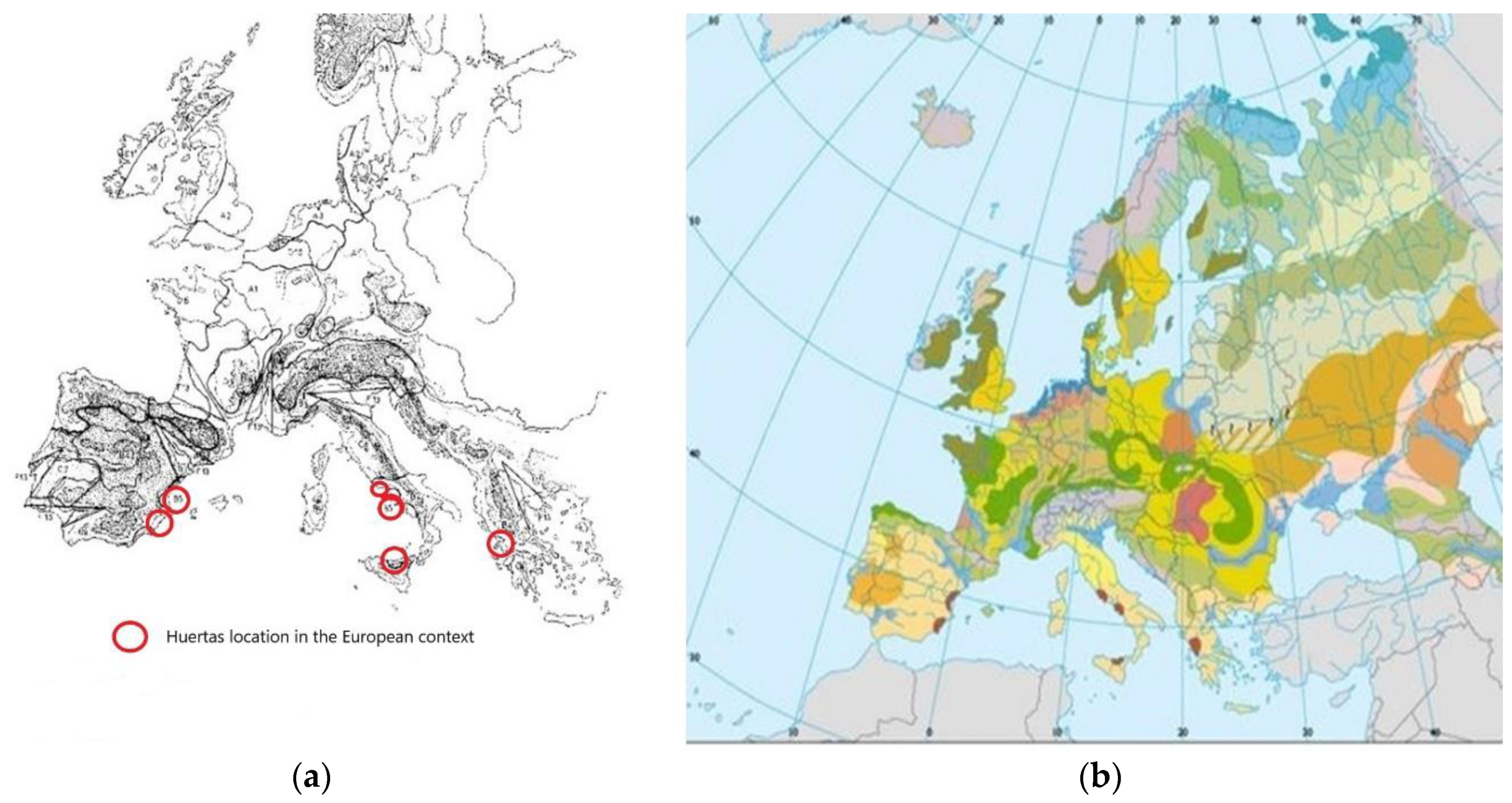
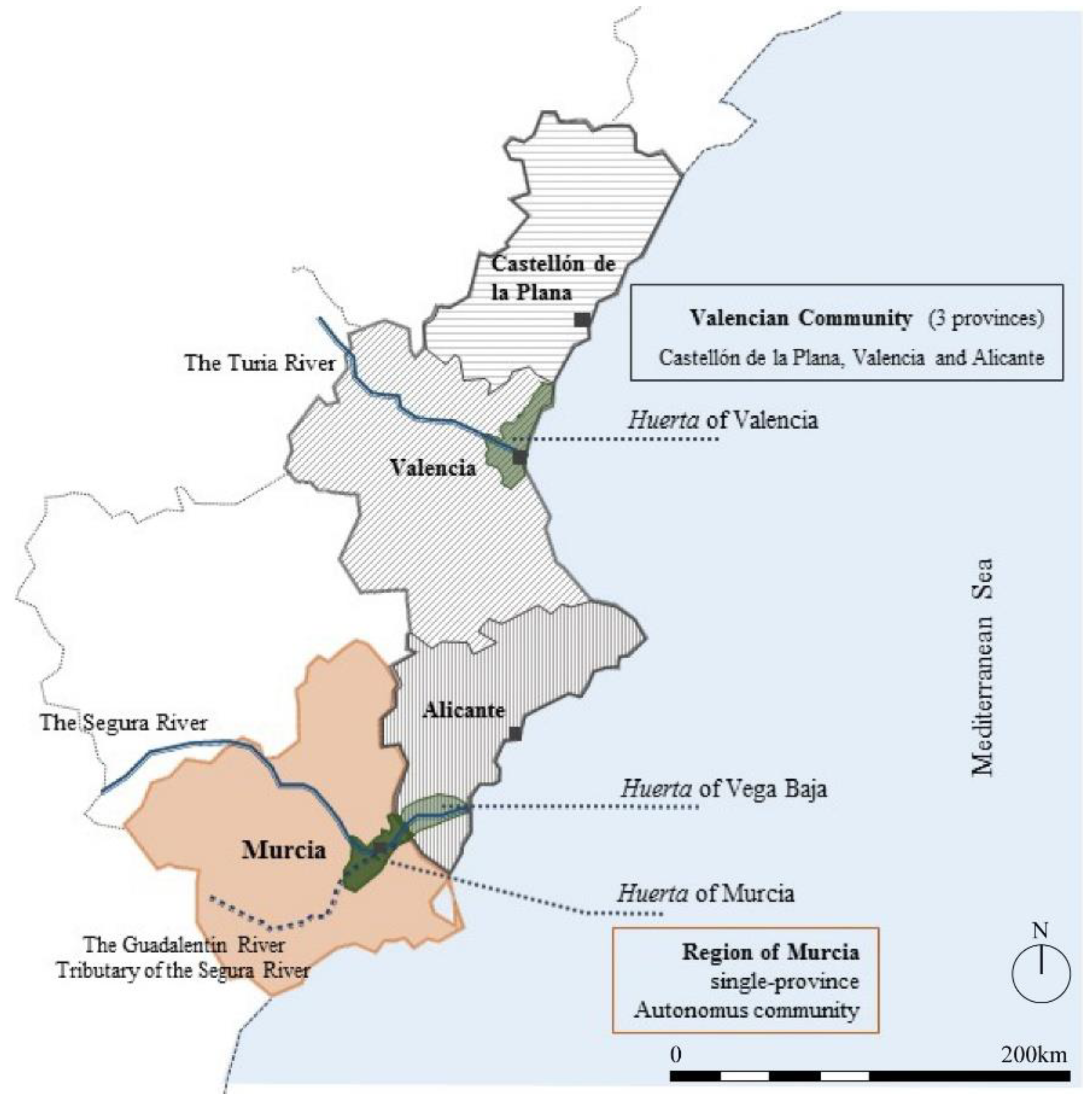
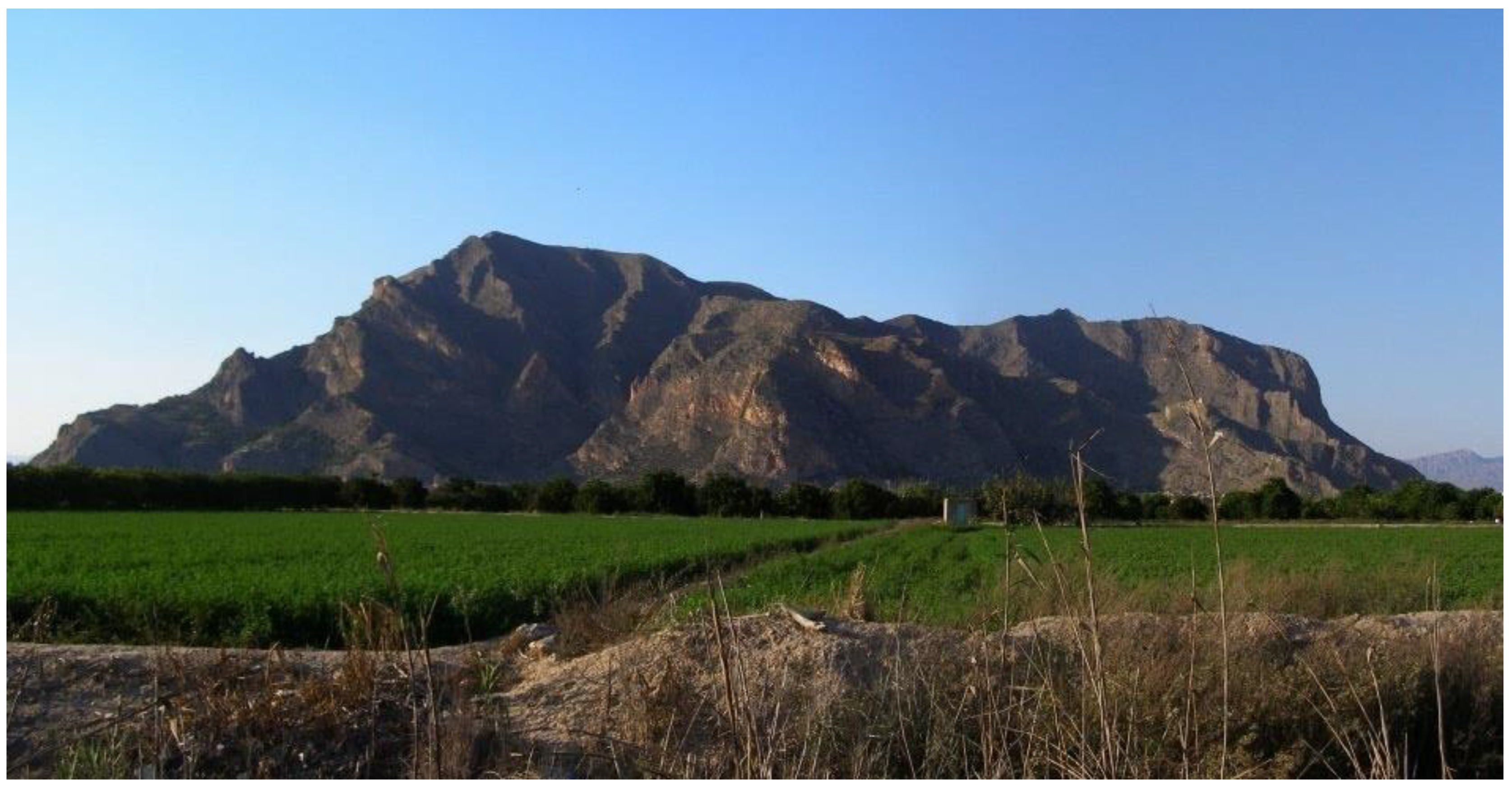
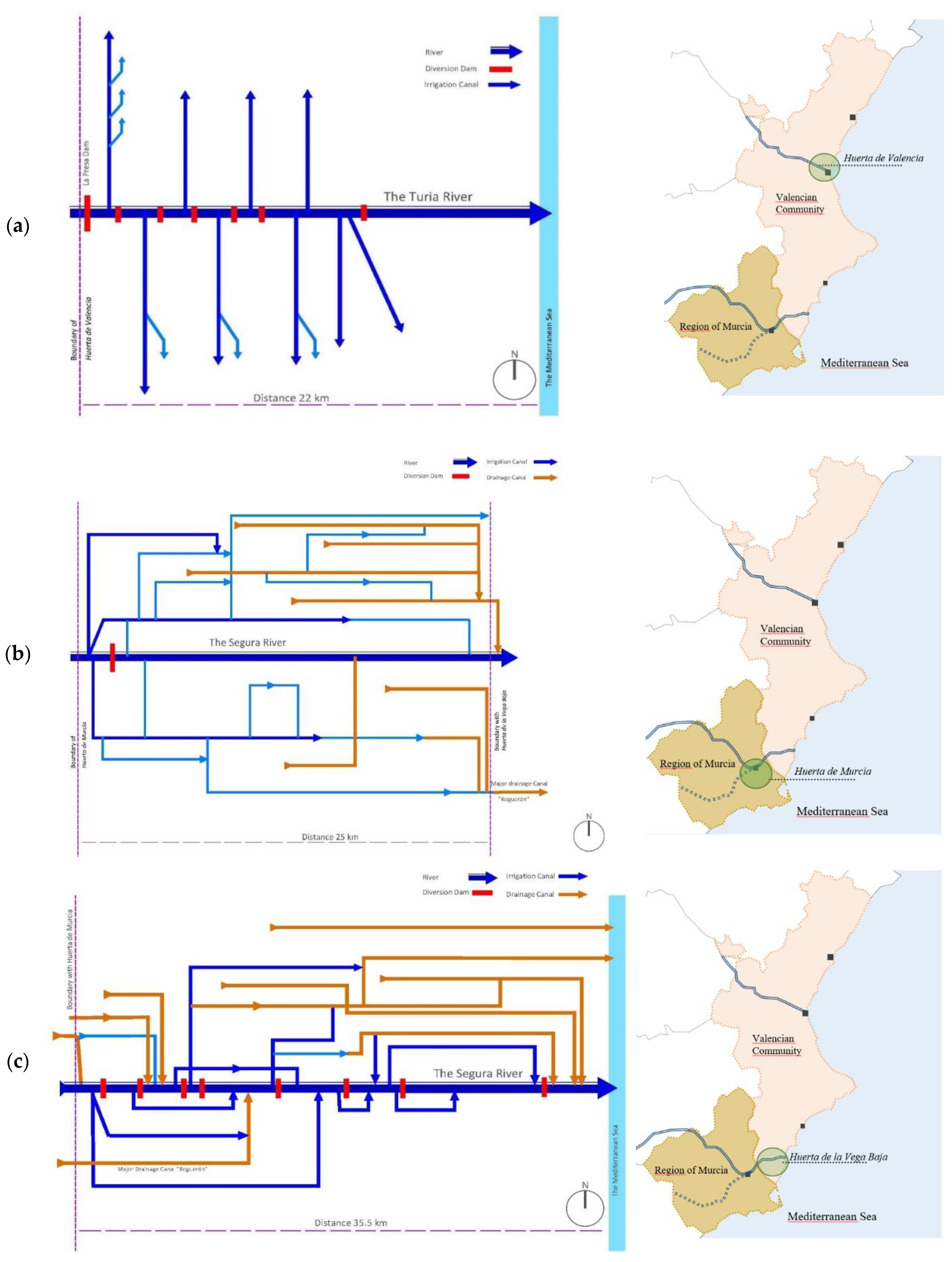
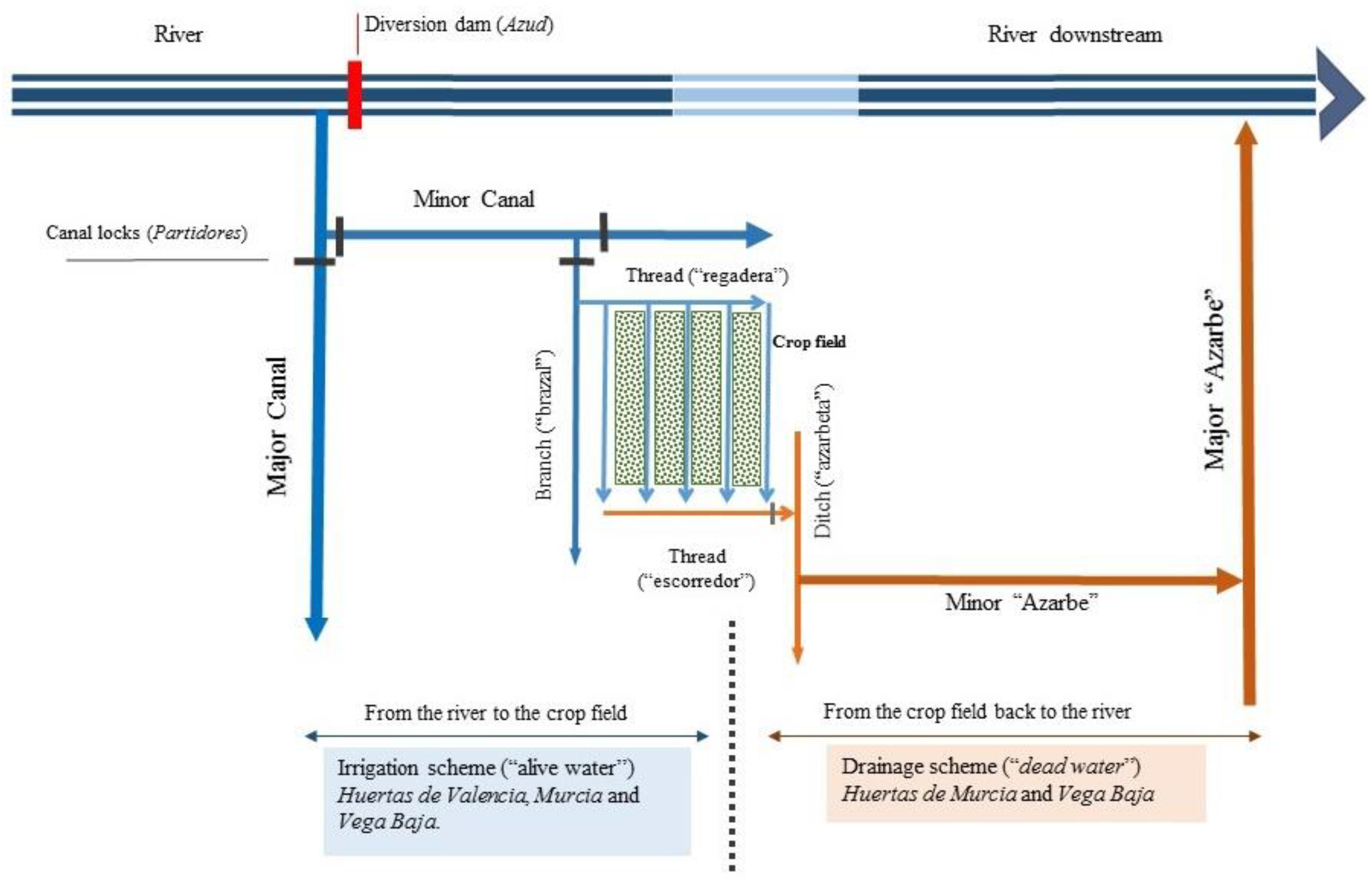
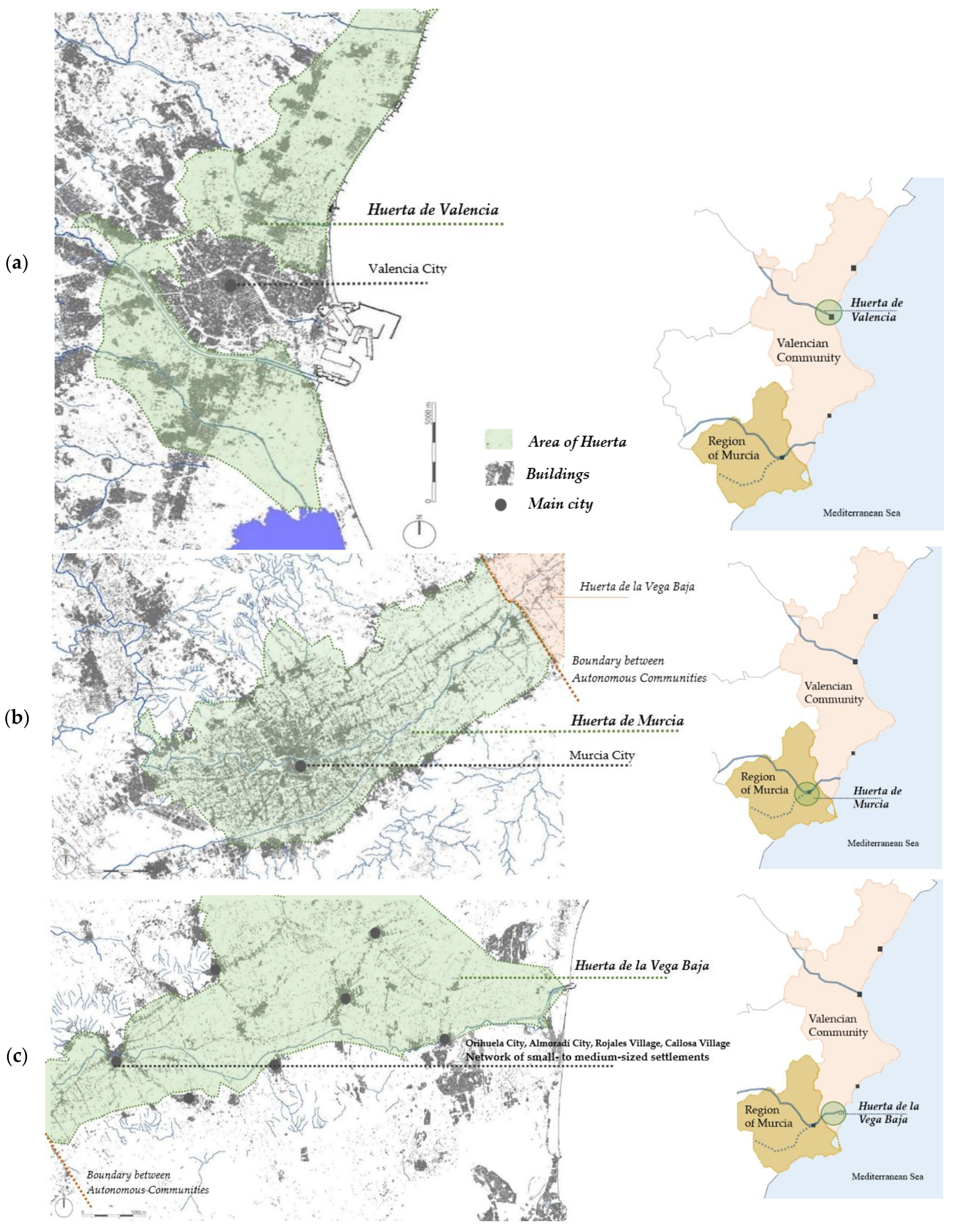
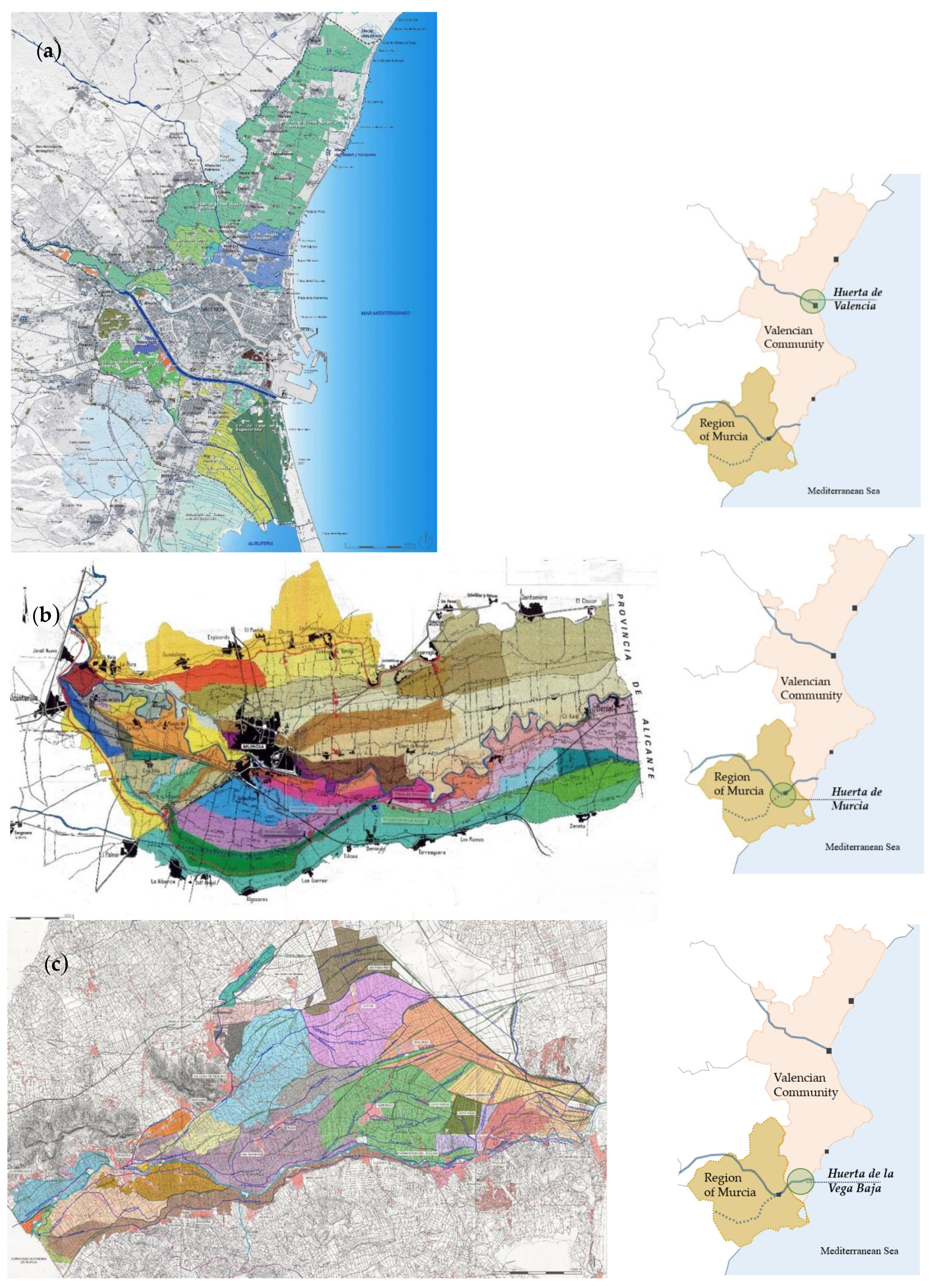
| Pathway Network | Width (Historical) 1 | Width (m) | Irrigation Network | Drainage Network | Width (Historical) | Width (m) | ||||
|---|---|---|---|---|---|---|---|---|---|---|
| Road | 5 | “vara” | 4.2 | m | The Segura River | 40 | spans | 9.04 | m | |
| Track | 10 | spans | 2.3 | m | Major Canal | Major “Azarbe” | 9.5 | spans | 2.15 | m |
| Horse trail | 6 | spans | 1.4 | m | Minor Canal | Minor “Azarbe” | 4.75 | spans | 1.07 | m |
| Horse trail | 6 | spans | 1.4 | m | Branch | Ditch | 4.75 | spans | 1.07 | m |
| Boundary | 3 | spans | 0.7 | m | Thread | Thread | 2.38 | spans | 0.54 | m |
| Huerta Landscape | |||
|---|---|---|---|
| Tangible Elements | Intangible Components | Issue Addressed | Correlation |
| Huerta physical space | Huerta proper noun | Landscape character and local identity | At local level the noun Huerta characterizes a unique agricultural system, with a cultural identity, clearly differentiated from other agricultural landscapes |
| Water-Canal network | Water management | Community trust, Social cohesion, Property structure. COOPERATION & COORDINATION | Water-canal network design and implementation is based on a deep knowledge of territorial features for each Huerta in order to obtain a maximum benefit from very scarce water resources. The right to water is inherent to the land itself, not to the landowner, and each plot perceives a different amount which depends on a proportion measured by slots of time. So, water management (distribution, corrective measures and control) is based on community trust and agreements in each water-canal network, but the specific regulations depend on each territorial particularities. |
| Irrigation communities jurisdiction | Social cohesion and Property structure | The number of Irrigation communities depend on the water-canal network design because is determined by the group of landowners irrigating from the same Major canal. Additionally, owners downstream depend on landowners’ upstream management. This means that community social cohesion has historically depend on the appropriate water manage balance. These communities are defined by both the water canal-network and the irrigation communities. | |
| Pathway networks | Property structure | Settlements location and type of crops have been historically linked to property structure. Generally, the property was based on smallholdings mainly because of the high productivity of the land. Additionally, plot size was historically determined by the irrigation-drainage canal network needs, where these canals were simultaneously plot and property boundary in many stretches. | |
| Canal and path upkeep rules | Property structure | There is a relation of interdependence between water-canal and pathway networks: accessibility to canal-lock management, accessibility to land plots, harvesting. This is a highly fragmented property system what implies the need of cooperation and coordination between landowners under the agreed regulations of the canal and path upkeep rules to have correctly maintained these dense path meshes. | |
| Agricultural productive system | COOPERATION & COORDINATION | ||
| Administration of Huertas’ territories. Water tribunal courts | Autonomous jurisdiction. Unanimous respect for decisions taken. COMMUNITY TRUST | Water is the key factor of the historical governance for the Huertas’ territories. Both, water as a resource and the infrastructural networks are under jurisdiction of specific courts. Historically, settlement location and their urban growth were based on the prioritisation of agricultural production and each decision affecting any Huerta area was also monitored by local water courts. | |
| Settlement patterns | |||
Publisher’s Note: MDPI stays neutral with regard to jurisdictional claims in published maps and institutional affiliations. |
© 2020 by the authors. Licensee MDPI, Basel, Switzerland. This article is an open access article distributed under the terms and conditions of the Creative Commons Attribution (CC BY) license (http://creativecommons.org/licenses/by/4.0/).
Share and Cite
Martí, P.; García-Mayor, C. The Huerta Agricultural Landscape in the Spanish Mediterranean Arc: One Landscape, Two Perspectives, Three Specific Huertas. Land 2020, 9, 460. https://doi.org/10.3390/land9110460
Martí P, García-Mayor C. The Huerta Agricultural Landscape in the Spanish Mediterranean Arc: One Landscape, Two Perspectives, Three Specific Huertas. Land. 2020; 9(11):460. https://doi.org/10.3390/land9110460
Chicago/Turabian StyleMartí, Pablo, and Clara García-Mayor. 2020. "The Huerta Agricultural Landscape in the Spanish Mediterranean Arc: One Landscape, Two Perspectives, Three Specific Huertas" Land 9, no. 11: 460. https://doi.org/10.3390/land9110460
APA StyleMartí, P., & García-Mayor, C. (2020). The Huerta Agricultural Landscape in the Spanish Mediterranean Arc: One Landscape, Two Perspectives, Three Specific Huertas. Land, 9(11), 460. https://doi.org/10.3390/land9110460






